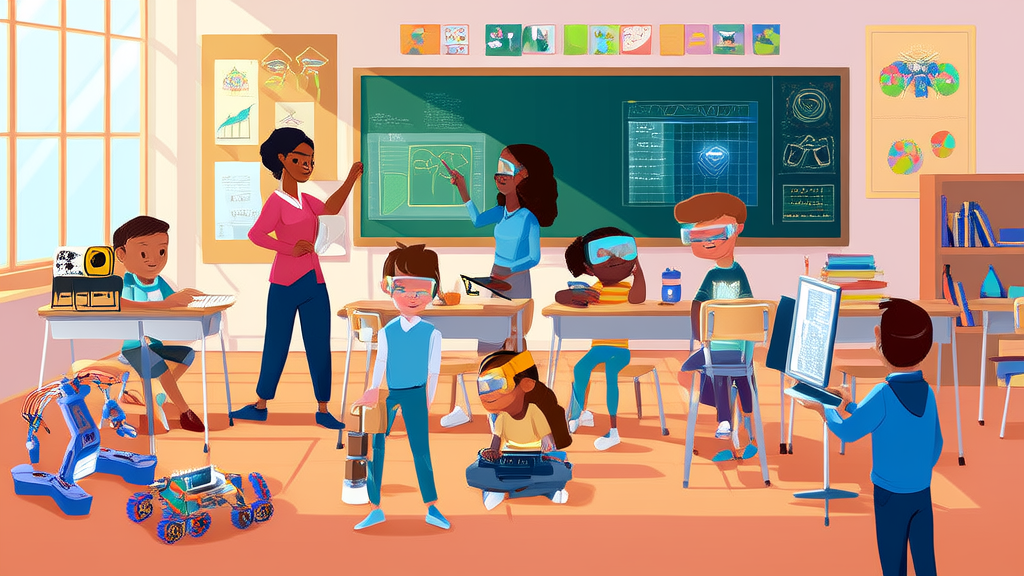5 Cutting-Edge K12 Innovations Transforming Student Success in 2025

Empowering the Next Generation: Navigating K12 Education in 2025
Welcome to the future of education! As we step into June 2025, the landscape of K12 education is more dynamic and innovative than ever. From cutting-edge teaching methodologies to the integration of educational technology, the ways in which we educate our children are evolving rapidly. This blog post aims to provide parents and educators with valuable insights, practical tips, and inspiring success stories that can help shape a brighter future for our students.
Latest Teaching Methodologies and Their Effectiveness
In recent years, several new teaching methodologies have emerged, each designed to enhance student engagement and learning outcomes. One such approach is project-based learning (PBL), where students work on long-term projects that require them to apply their knowledge and skills to real-world problems. Research has shown that PBL not only improves academic performance but also fosters critical thinking, collaboration, and creativity.
Another effective method is flipped classrooms, where traditional lecture and homework elements are reversed. Students watch video lectures at home and then use class time for interactive activities, discussions, and problem-solving. This approach has been particularly successful in subjects like mathematics and science, where hands-on practice is crucial.
Child Development Insights and Research
Understanding child development is key to creating an effective learning environment. Recent research highlights the importance of social-emotional learning (SEL) in K12 education. SEL programs focus on developing students' self-awareness, self-management, social awareness, relationship skills, and responsible decision-making. Studies have shown that SEL not only improves academic performance but also reduces behavioral issues and enhances overall well-being.
Additionally, the concept of growth mindset has gained traction. Developed by psychologist Carol Dweck, the growth mindset emphasizes the belief that abilities and intelligence can be developed through dedication and hard work. Encouraging a growth mindset in students can lead to increased resilience, motivation, and a love for learning.
Educational Technology Trends
Technology continues to play a pivotal role in K12 education. One of the most significant trends is the use of adaptive learning platforms. These platforms use algorithms to tailor the learning experience to each student's individual needs, providing personalized content and pacing. Tools like DreamBox Learning and Khan Academy have been highly effective in helping students master difficult concepts at their own pace.
Another trend is the integration of augmented reality (AR) and virtual reality (VR) in the classroom. AR and VR technologies offer immersive learning experiences that can bring abstract concepts to life. For example, students can explore historical sites, conduct virtual science experiments, or even travel to outer space, all from the comfort of their classroom. These technologies not only make learning more engaging but also help students develop a deeper understanding of complex topics.
Practical Tips for Parents and Teachers
For Parents:
- Stay involved in your child's education. Regularly communicate with teachers and attend parent-teacher conferences to stay informed about your child's progress.
- Encourage a growth mindset at home. Praise effort and persistence rather than innate ability, and model a positive attitude towards challenges.
- Support your child's social-emotional development. Engage in open conversations, teach empathy, and provide opportunities for them to build relationships and resolve conflicts.
For Teachers:
- Implement project-based learning and flipped classrooms to create a more engaging and interactive learning environment.
- Integrate social-emotional learning into your curriculum. Use resources like CASEL (Collaborative for Academic, Social, and Emotional Learning) to guide your efforts.
- Leverage educational technology to personalize learning. Explore adaptive learning platforms and consider incorporating AR and VR to enhance the learning experience.
Success Stories and Case Studies
One inspiring success story comes from the High Tech High network of schools in California. These schools have fully embraced project-based learning, resulting in high levels of student engagement and academic achievement. Students at High Tech High regularly complete complex, interdisciplinary projects that prepare them for college and careers.
Another notable case is the Summit Public Schools in the United States. Summit has implemented a personalized learning platform that allows students to set and track their own learning goals. This approach has led to significant improvements in student performance and graduation rates.
Conclusion
The future of K12 education is bright, thanks to innovative teaching methodologies, a deeper understanding of child development, and the integration of educational technology. By staying informed and implementing these best practices, parents and educators can create a nurturing and effective learning environment for our children. Let's work together to empower the next generation and ensure they are well-prepared for the challenges and opportunities that lie ahead.
Join the conversation and share your thoughts and experiences in the comments below. Together, we can make a difference in the lives of our students.